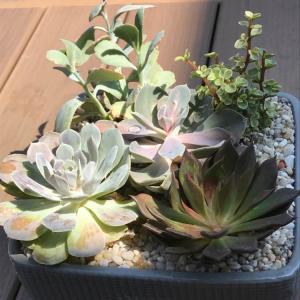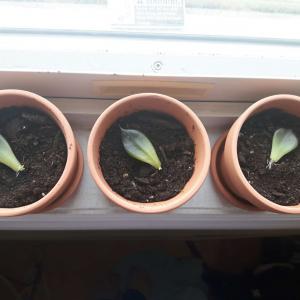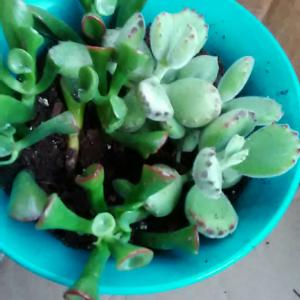lizi_mayk
2017年05月31日

It's my new garden! I bought some new, and now are growing about 19 succulents!


0
0
求助
Dimitri Hicks
2017年05月28日

I just picked up these two succulents today and i can not find anywhere what they are if anyone can help thatd be amazing
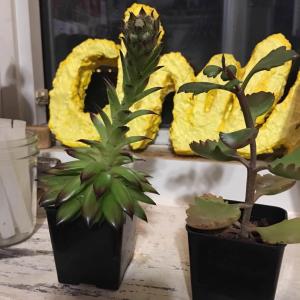
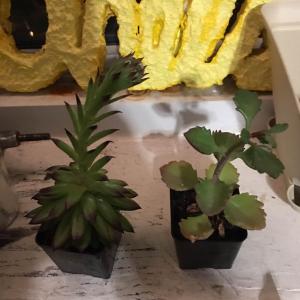


2
0
求助
Lucky Coyote
2017年05月27日

I got a surprise pot of succulents and need some help identifying them 😻






0
0
Cleaux:Haworthia pumila for the textured spotty green ones. I think you have a gasteraloe hybrid in there as well. I agree with the black aeonuoms!
EverythingForCacti:Green ones May be Haworthias or Aloes
Ueca:The ones that look like palm trees are Black Aeoniums.
求助
Lucky Coyote
2017年05月26日

i found these super tiny succulents at my aunt's place today, any ideas on what they might be?
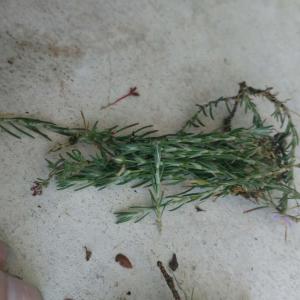
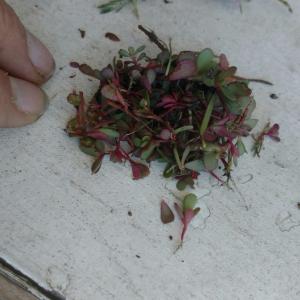


0
0
Misspgy:@Neverdense I believe the right picture is edible
Lucky Coyote:@Neverdense I'm not sure if it helps, but the left made my hand itch really bad
Lintonion:The right looks like a crassula hybrid
Neverdense:Left looks like Rosemary
求助
Aurora
2017年05月23日
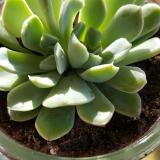
almost all of these type of succulents are have have this weird brown marking on them. should I just take the leaves a propagate them to get better looking ones?
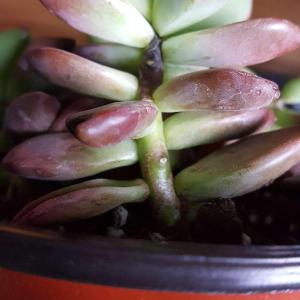
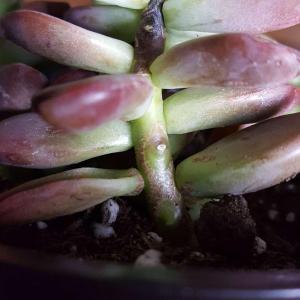


0
0
Aurora:@玛姬珂 oh wow really I'll do that right away then thank you!
玛姬珂:cut it off, or it will die
美好:黑腐了
Aurora:succulents I have*
文章
Colorful
2017年05月23日
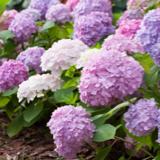
Unique looking succulents can make your rooms look better, also, they are low-maintenance and easiest plants to grow. Check out the 14 best indoor succulents for your home!
Are you looking for the one ingredient that’s capable of making any room look much better? The answer is indoor plants. After the failure of faux plants, indoor houseplants are back in fashion, and why not. A splatter of healthy greenery in your room can make it feel instantly welcoming and fresh. Another good reason to plant indoor plants is they purify air and in turn create a healthier living place.
Also Read: Plants for a Restful Sleep
Now face it, not all houseplants are easy to grow, especially for beginners. However, succulents, when grown as houseplants, adjust well to indoor conditions and are easiest to grow. And that’s why we’ve made a selection of succulents that are popular and easiest to grow.
Also Read: The Most Easy to Grow Houseplants
1. Burro’s Tail (Sedum morganianum)
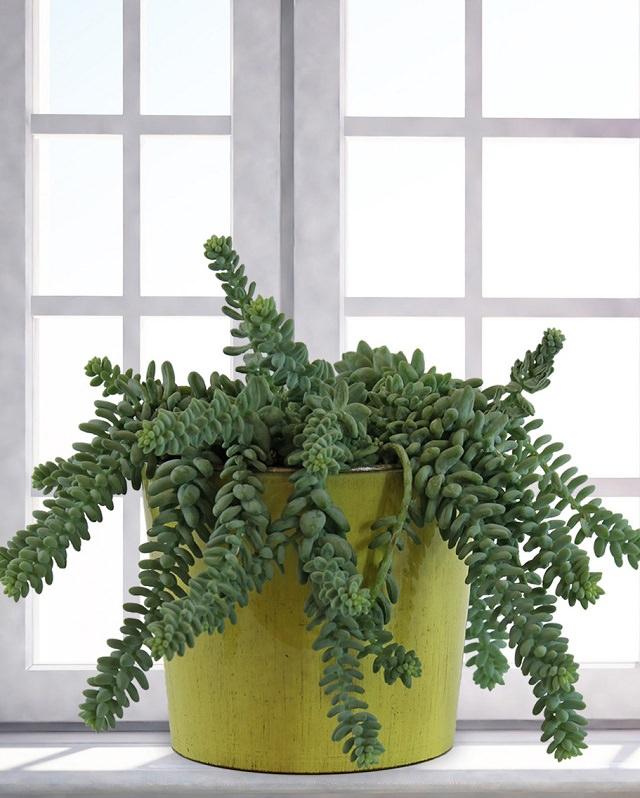
A native of Mexico, Burro’s tail is best planted in hanging baskets due to its fat trailing stems. Its beautiful gray-blue or gray-green leaves can grow up to 2 feet long. This plant does best when kept in a spot that receives bright sun.
Growing TipsLet the soil dry out between watering spells, and ensure that soil is kept on a dry side in times of winter dormancy, especially, if you’re growing it in a cool-temperate zone.Fertilize the plant once in summer using a 10:10:10 fertilizer or any cactus fertilizer.Leaves will fall off with the slightest of touches, so it is important the plant is placed where there will be a minimal disturbance.If you have to move it outside for the summer sun, ensure it will acclimate well before keeping it in a full sun.
2. Zebra Cactus (Haworthia fasciata)

Native to the African continent, the zebra plant perch on top of the soil and sports a neat for of leaves which boasts stunning horizontal white stripes. The beauty of this little plant is that it looks exceptional, takes a small space and requires little to no care.
Growing TipsUse a shallow pot since the roots don’t penetrate the soil deeply.Repot it at the interval of 12-24 months with the fresh succulent potting mix for optimum growth.Allow the soils to nearly dry out between watering spells. It’s important for all the succulents.The zebra plant is best placed in a bright spot so as not to expose the plant to the direct sun lest it becomes shriveled.
3. Aloe vera
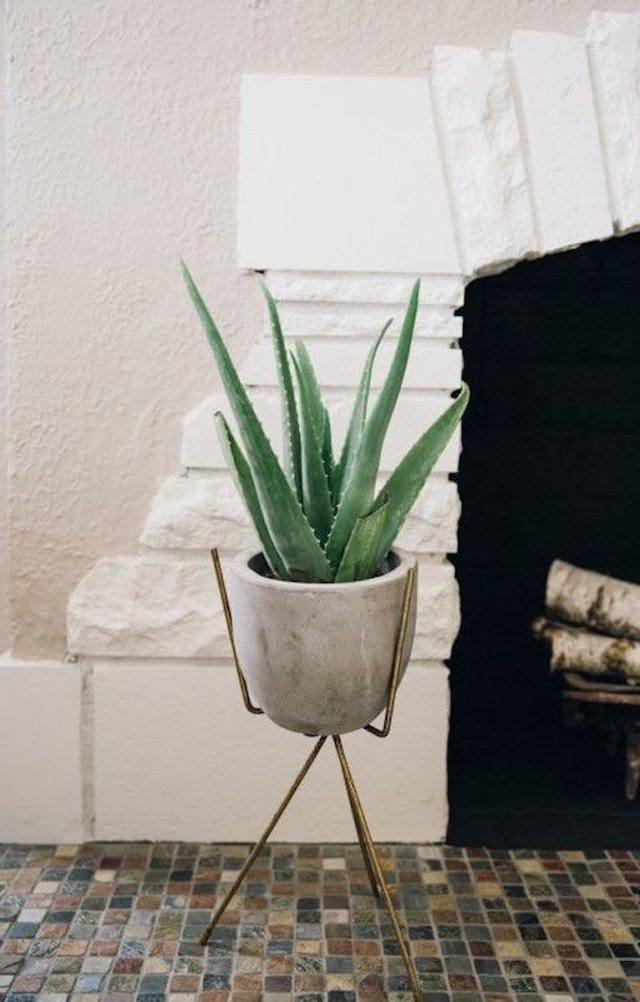
Aloe vera is a medicinal plant, a succulent whose sap has been used to treat sunburn and wounds for centuries. Medicinal value aside, aloe vera is also a great indoor plant. Because the sharp thorns along the margin of the leaves can cut people, the plant is best placed somewhere it can’t be accidentally brushed or fall.
Growing TipsLet the soil dry between soakings.Put it where it can get a couple of hours of sunlight daily.Fertilize the plant twice during the growing season using a balanced 10:10:10 fertilizer but don’t fertilize in winter.Do not repot unless the roots start to push their way out of the pot.
Also Read: How to Care for an Aloe Plants
4. Crown of Thorns (Euphorbia milii)
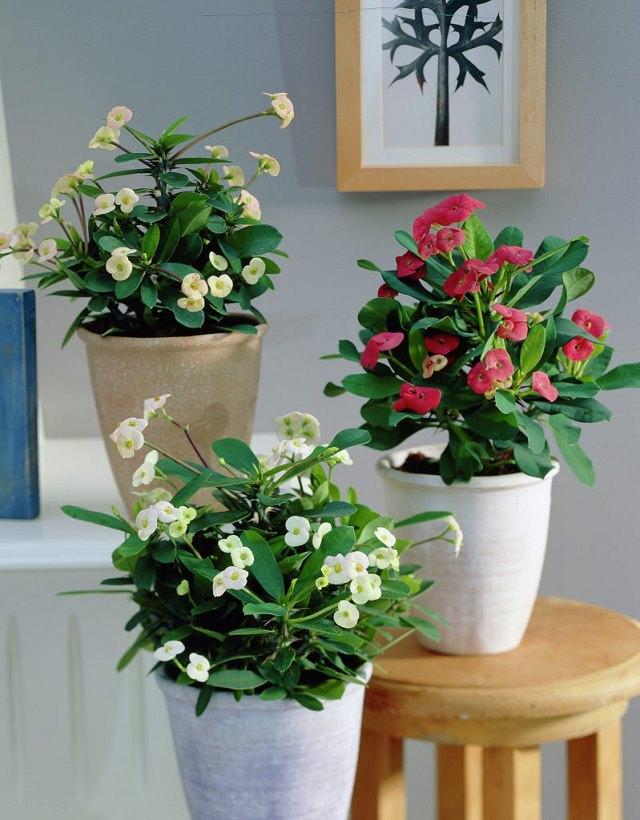
Native to Madagascar, this plant can bloom throughout the year provided you give it enough light. Long and spoon-shaped leaves appear at the end of its spiky branches, together with tiny flowers. The flowers are not noticeable because of their small size, but you will see yellow, red or salmon bracts surround them that looks attractive.
Growing TipsThis plant has low to moderate watering needs.Avoid letting the whole pot dry out or it will drop leaves.Direct light will give you the best bloom although the plant can also adapt to medium-light conditions.Fertilize 2-3 times with a balanced 10:10:10 fertilizer during the growing season.
5. Hens-and-Chicks
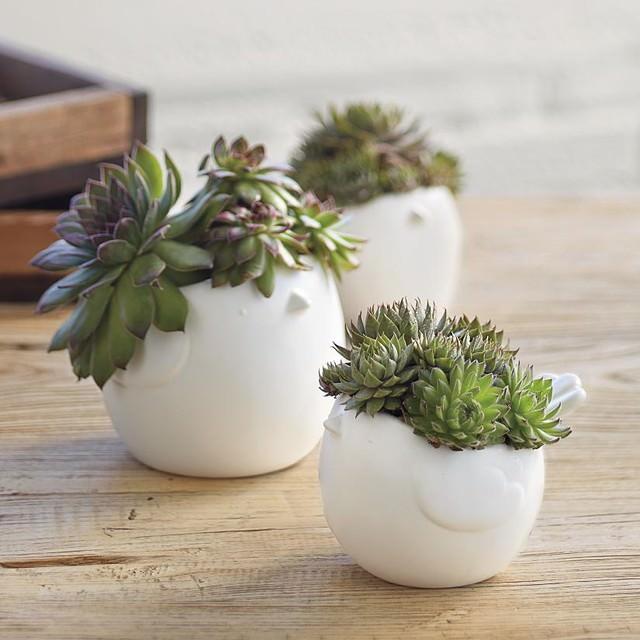
The Hens-and-Chick plants are another great succulent group of plants for indoor gardening, they form flat flowerlike rosettes that have rounded edges. These plants need to be allowed to dry a bit between watering since overwatering can cause rotting.
Growing TipsWater very infrequently during winter dormancy, if growing in a cooler region.Keep these plants in a bright spot, they can also tolerate light shade.You can propagate the plants by cuttings.
6. String of Bananas
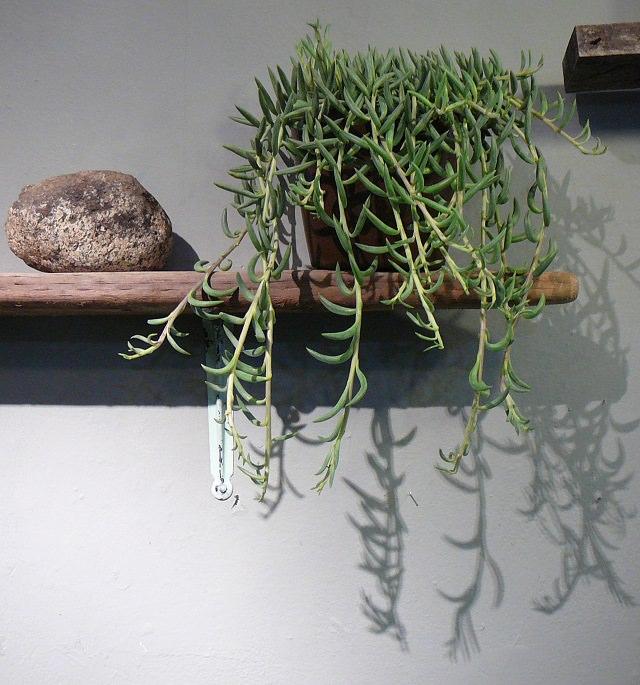
The trailing indoor succulent plant produces long tendrils of small banana-like leaves. The plant looks great when planted on its own and should be pruned regularly to grow thick and full. It also works beautifully when put in a pot containing other succulent indoor plants.
Growing TipsIt requires filtered sunlightWater the plant when soil is dry to touchIt does well in porous soil with excellent drainage.It is toxic, so you need to keep it away from pets and children who might munch it.
7. Lithops

Lithops are unique small and inconspicuous succulent plants that look like stones or pebbles. Growing lithops is very easy and don’t require much care.
Growing TipsKeep the plant in a sunny location, a south or west facing window would be best, away from drafts.Grow lithops in poor, well-drained soil.Stop watering your lithops plants in winter (in cooler zones).
8. Christmas Cactus (Schlumbergera x buckleyi)
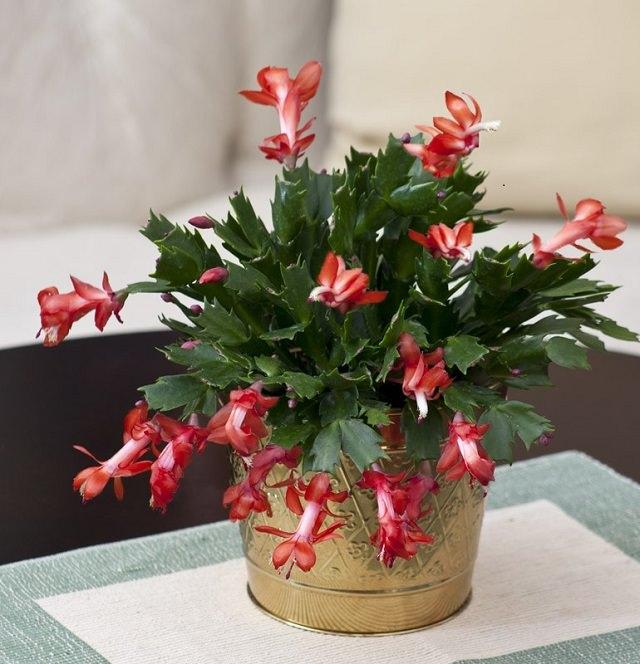
Christmas cactus needs no introduction, it is one of the most beautiful succulent plants, it looks good even without the flowers.
Growing TipsFor this plant to grow, allow the top 2 inches of the soil to dry between watering spells.Keep the plant on a dry side during winter. When it is in bud stage, be very careful since even the slightest overwatering or dehydration can lead to dropping of buds.
9. Ponytail palm (Beaucarnea recurvata)
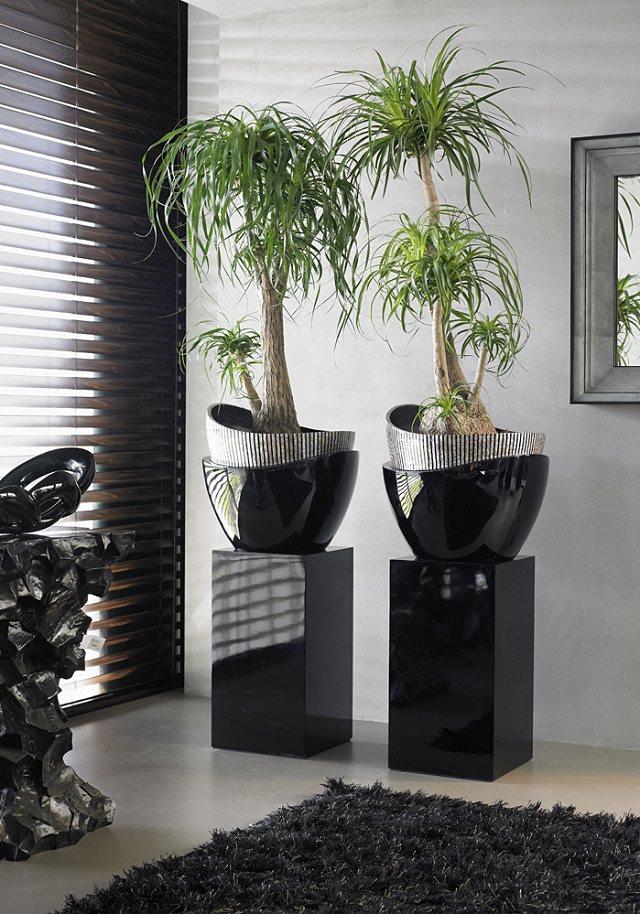
Ponytail palm is not a palm but a succulent. Probably, one of the most appealing houseplants and best in large houseplants. Its water is stored in the swollen stem base, which looks like elephant’s foot that’s why it’s also called “Elephant Foot Palm”.
Growing TipsIt grows well in sunny spots but can be grown in all day long bright indirect sunlight.It’s a plant and forget kind of plant when it comes to watering. Avoid watering regularly and let the top soil dry out before watering again.
10. Snake Plant
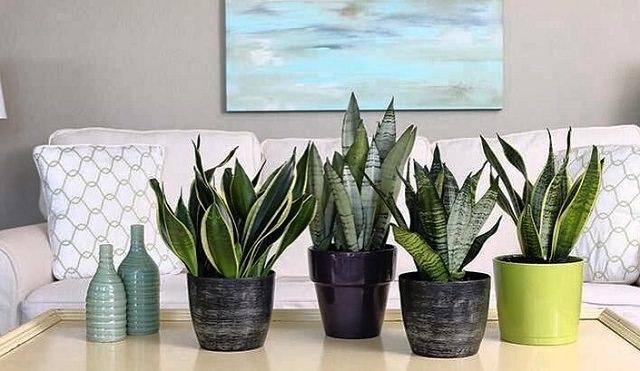
The snake plant or Mother-in-law’s tongue the most low maintenance plant in this list of best succulent plants for indoors and it is well-deserved! We also listed it in our post– Plants You can Grow without Sunlight. And why not, this succulent plant can survive in the darkest of corners and requires very low maintenance.
Growing TipsWater moderately.As snake plant is a very forgiving plant, you can place it in dim spots.
11. String of Pearls

The string of pearls is an exceptional trailing houseplant, very appealing indoors when grown in hanging baskets. You can experiment to grow it in different containers. Like other succulent houseplants growing string of pearls or beads is no different.
Growing TipsKeep the string of pearl plant in a bright light.Be careful with watering, this plant has low watering needs but in warmer regions, moderate watering is required.
12. Panda Plant (Kalanchoe tomentosa)
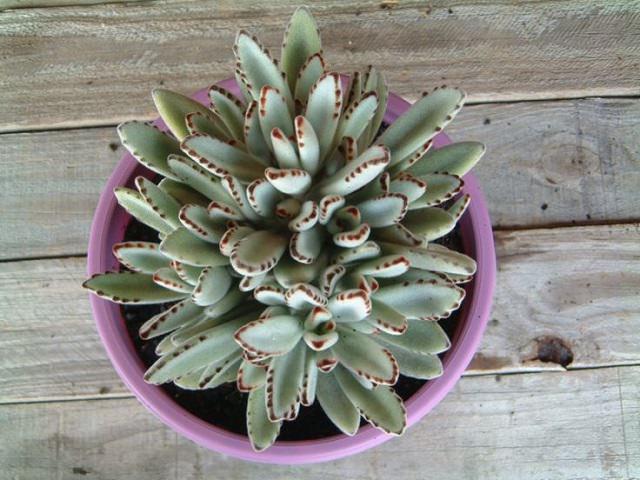
The silver gray hair of this plant makes it look fuzzy, the leaves are fat like other succulents and have rusty color on edges, like many other plants of kalanchoe genus the plant forms flowers too. However, they rarely bloom in indoor conditions.
Growing TipsKeeping the panda plant in a spot that receives bright indirect light and a couple of hours of direct sunlight is a good idea.Water infrequently and let the plant to dry out between the watering spells.Feed the plant once in a month during the growing season.Save the plant from cold and draft, normal room temperature is perfect.
13. Kalanchoe blossfeldiana
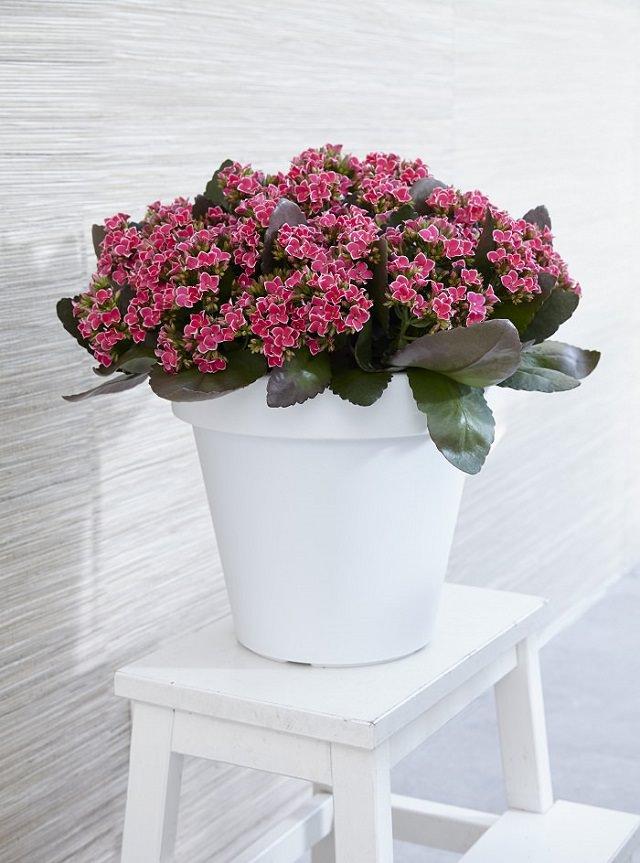
Kalanchoe blossfeldiana is one of the best flowering houseplants you can grow. Plants of this genus grow best outdoors in warm climates. However, it can be grown indoors. This flowering succulent comes in a variety of colors.
Growing TipsLow watering needs.The plant needs to be in a sunny spot to bloom.
Also Read: Flowering Houseplants
14. Pencil Cactus (Euphorbia tirucalli)

Pencil cactus became one of the most popular succulent houseplants from last few years and why not this unique African plant can grow up to 6 feet tall indoors and looks so different, quite a few houseplants like fiddle leaf fig can achieve such height.
Growing TipsKeep the plant near a sunny window.Water every couple of weeks, the plant has low watering needs.Use well-drained, gritty soil.Repot the plant every year or when you find it rootbound.
Are you looking for the one ingredient that’s capable of making any room look much better? The answer is indoor plants. After the failure of faux plants, indoor houseplants are back in fashion, and why not. A splatter of healthy greenery in your room can make it feel instantly welcoming and fresh. Another good reason to plant indoor plants is they purify air and in turn create a healthier living place.
Also Read: Plants for a Restful Sleep
Now face it, not all houseplants are easy to grow, especially for beginners. However, succulents, when grown as houseplants, adjust well to indoor conditions and are easiest to grow. And that’s why we’ve made a selection of succulents that are popular and easiest to grow.
Also Read: The Most Easy to Grow Houseplants
1. Burro’s Tail (Sedum morganianum)

A native of Mexico, Burro’s tail is best planted in hanging baskets due to its fat trailing stems. Its beautiful gray-blue or gray-green leaves can grow up to 2 feet long. This plant does best when kept in a spot that receives bright sun.
Growing TipsLet the soil dry out between watering spells, and ensure that soil is kept on a dry side in times of winter dormancy, especially, if you’re growing it in a cool-temperate zone.Fertilize the plant once in summer using a 10:10:10 fertilizer or any cactus fertilizer.Leaves will fall off with the slightest of touches, so it is important the plant is placed where there will be a minimal disturbance.If you have to move it outside for the summer sun, ensure it will acclimate well before keeping it in a full sun.
2. Zebra Cactus (Haworthia fasciata)

Native to the African continent, the zebra plant perch on top of the soil and sports a neat for of leaves which boasts stunning horizontal white stripes. The beauty of this little plant is that it looks exceptional, takes a small space and requires little to no care.
Growing TipsUse a shallow pot since the roots don’t penetrate the soil deeply.Repot it at the interval of 12-24 months with the fresh succulent potting mix for optimum growth.Allow the soils to nearly dry out between watering spells. It’s important for all the succulents.The zebra plant is best placed in a bright spot so as not to expose the plant to the direct sun lest it becomes shriveled.
3. Aloe vera

Aloe vera is a medicinal plant, a succulent whose sap has been used to treat sunburn and wounds for centuries. Medicinal value aside, aloe vera is also a great indoor plant. Because the sharp thorns along the margin of the leaves can cut people, the plant is best placed somewhere it can’t be accidentally brushed or fall.
Growing TipsLet the soil dry between soakings.Put it where it can get a couple of hours of sunlight daily.Fertilize the plant twice during the growing season using a balanced 10:10:10 fertilizer but don’t fertilize in winter.Do not repot unless the roots start to push their way out of the pot.
Also Read: How to Care for an Aloe Plants
4. Crown of Thorns (Euphorbia milii)

Native to Madagascar, this plant can bloom throughout the year provided you give it enough light. Long and spoon-shaped leaves appear at the end of its spiky branches, together with tiny flowers. The flowers are not noticeable because of their small size, but you will see yellow, red or salmon bracts surround them that looks attractive.
Growing TipsThis plant has low to moderate watering needs.Avoid letting the whole pot dry out or it will drop leaves.Direct light will give you the best bloom although the plant can also adapt to medium-light conditions.Fertilize 2-3 times with a balanced 10:10:10 fertilizer during the growing season.
5. Hens-and-Chicks

The Hens-and-Chick plants are another great succulent group of plants for indoor gardening, they form flat flowerlike rosettes that have rounded edges. These plants need to be allowed to dry a bit between watering since overwatering can cause rotting.
Growing TipsWater very infrequently during winter dormancy, if growing in a cooler region.Keep these plants in a bright spot, they can also tolerate light shade.You can propagate the plants by cuttings.
6. String of Bananas

The trailing indoor succulent plant produces long tendrils of small banana-like leaves. The plant looks great when planted on its own and should be pruned regularly to grow thick and full. It also works beautifully when put in a pot containing other succulent indoor plants.
Growing TipsIt requires filtered sunlightWater the plant when soil is dry to touchIt does well in porous soil with excellent drainage.It is toxic, so you need to keep it away from pets and children who might munch it.
7. Lithops

Lithops are unique small and inconspicuous succulent plants that look like stones or pebbles. Growing lithops is very easy and don’t require much care.
Growing TipsKeep the plant in a sunny location, a south or west facing window would be best, away from drafts.Grow lithops in poor, well-drained soil.Stop watering your lithops plants in winter (in cooler zones).
8. Christmas Cactus (Schlumbergera x buckleyi)

Christmas cactus needs no introduction, it is one of the most beautiful succulent plants, it looks good even without the flowers.
Growing TipsFor this plant to grow, allow the top 2 inches of the soil to dry between watering spells.Keep the plant on a dry side during winter. When it is in bud stage, be very careful since even the slightest overwatering or dehydration can lead to dropping of buds.
9. Ponytail palm (Beaucarnea recurvata)

Ponytail palm is not a palm but a succulent. Probably, one of the most appealing houseplants and best in large houseplants. Its water is stored in the swollen stem base, which looks like elephant’s foot that’s why it’s also called “Elephant Foot Palm”.
Growing TipsIt grows well in sunny spots but can be grown in all day long bright indirect sunlight.It’s a plant and forget kind of plant when it comes to watering. Avoid watering regularly and let the top soil dry out before watering again.
10. Snake Plant

The snake plant or Mother-in-law’s tongue the most low maintenance plant in this list of best succulent plants for indoors and it is well-deserved! We also listed it in our post– Plants You can Grow without Sunlight. And why not, this succulent plant can survive in the darkest of corners and requires very low maintenance.
Growing TipsWater moderately.As snake plant is a very forgiving plant, you can place it in dim spots.
11. String of Pearls

The string of pearls is an exceptional trailing houseplant, very appealing indoors when grown in hanging baskets. You can experiment to grow it in different containers. Like other succulent houseplants growing string of pearls or beads is no different.
Growing TipsKeep the string of pearl plant in a bright light.Be careful with watering, this plant has low watering needs but in warmer regions, moderate watering is required.
12. Panda Plant (Kalanchoe tomentosa)

The silver gray hair of this plant makes it look fuzzy, the leaves are fat like other succulents and have rusty color on edges, like many other plants of kalanchoe genus the plant forms flowers too. However, they rarely bloom in indoor conditions.
Growing TipsKeeping the panda plant in a spot that receives bright indirect light and a couple of hours of direct sunlight is a good idea.Water infrequently and let the plant to dry out between the watering spells.Feed the plant once in a month during the growing season.Save the plant from cold and draft, normal room temperature is perfect.
13. Kalanchoe blossfeldiana

Kalanchoe blossfeldiana is one of the best flowering houseplants you can grow. Plants of this genus grow best outdoors in warm climates. However, it can be grown indoors. This flowering succulent comes in a variety of colors.
Growing TipsLow watering needs.The plant needs to be in a sunny spot to bloom.
Also Read: Flowering Houseplants
14. Pencil Cactus (Euphorbia tirucalli)

Pencil cactus became one of the most popular succulent houseplants from last few years and why not this unique African plant can grow up to 6 feet tall indoors and looks so different, quite a few houseplants like fiddle leaf fig can achieve such height.
Growing TipsKeep the plant near a sunny window.Water every couple of weeks, the plant has low watering needs.Use well-drained, gritty soil.Repot the plant every year or when you find it rootbound.
8
9
文章
Gina
2017年05月23日


If your vision of growing cactus involves a dry desert look, think again. Cactus and succulents are one of the hottest garden trends going on right now, and we all should give them a little look. Live in a northern climate and don’t think you can grow them? We cover that too. Here’s how to grow cactus, and some great inspiration in using them as a modern design element to update any garden or landscaping .
Basics Needs of Cactus
First of all, when most of us think of cactus, we think of the varieties meant for desert environments. While there are many beautiful ones that grow down south, most people don’t know that there are several hardy varieties as well. Check with your local nursery, then check out our guidelines for growing in northern gardens. So number one is that they need to be well matched with their planting zone.
Second, all cacti need well drained soil. Grow them in a mix of 50 percent soil to 50 percent coarse sand. If growing in containers, use a commercially available cacti mix.
They need very little water. If you live in an area that gets rain in the summer, than that is probably all they need. If they grow in containers, let them dry out completely before watering.
They need little fertilizer. For blooming varieties, you may wish to give them a diluted drink of liquid fertilizer just as they start setting buds.
They need full sun. Duh.
Growing them in the North
So the only trick to growing cacti in the north is to grow the proper varieties. Better Homes and Gardens has a good article on just that right here.
Contain Your Cactus
If you don’t want to be held back by your climate, keep in mind cacti do well in containers. They can be brought inside during the winter to a sun room or other bright warm space. Three tips for you…
Use gloves. Another duh.
Use a well drained soil mix made for cacti.
Don’t over water.
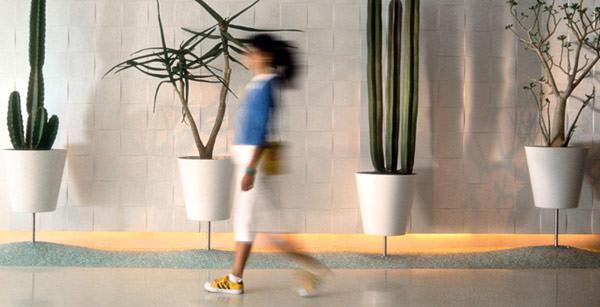
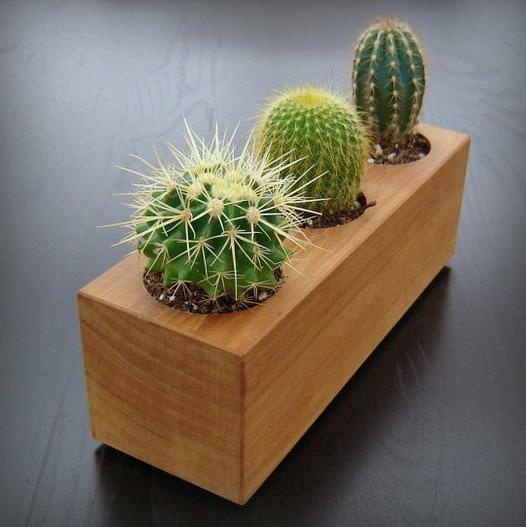
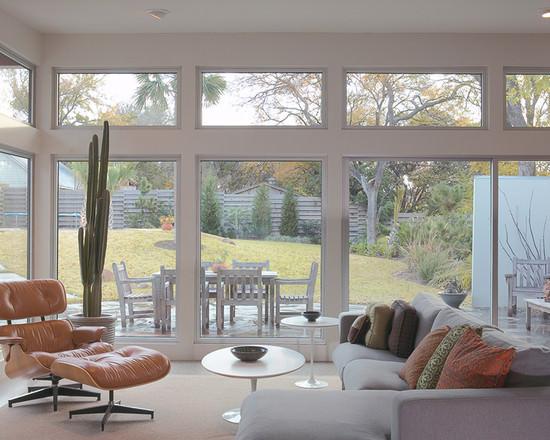
Texture, Design and Interest
So here is where the appreciation for cacti comes in. Fewer plants on this earth have such amazing adaptive qualities. They are a lesson in form and function, in the beauty of Mother Nature and a lesson in her harshness as well. Used in a repeat pattern they are an exceptional design element. Nothing adds more texture and interest to a garden. Aren’t convinced? Check out these inspiring photos.
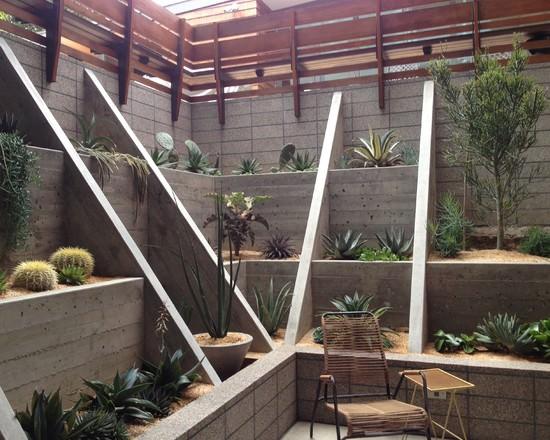

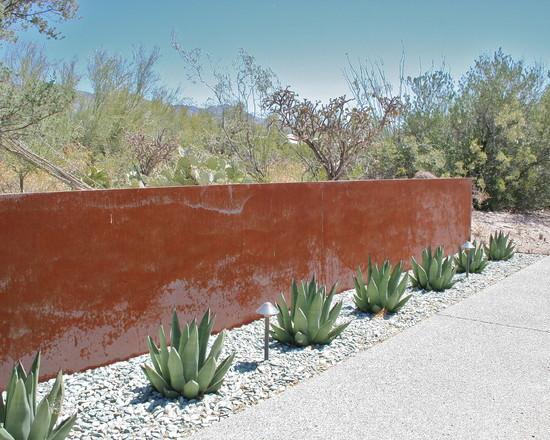

Growing cactus can be an adventure in modern gardening, and can be the beginning of a whole new obsession no matter where you live!
0
0
文章
扭扭
2017年05月23日

Learn how to make a vertical succulent wall planter in a few steps without spending money. You don’t need to be a great DIYer to have this DIY succulent frame in your home.

Succulents are easiest plants to grow on earth. They are not demanding and most of them grow in severe conditions, plus they come in different colors, sizes, and shapes. All this makes them perfect for vertical gardening.
Things you’ll need to make DIY succulent wall planter

SucculentA tape to measureChicken wireA hammerNailsA pencil or MarkerGlueSpecial potting mix for cacti and succulentsMore succulents4 equal size thick sticks or frame moulding to make frameMoss (Optional)A piece of board (plywood or something else) to adhere behind the frame.Staple gun or whatever you find easily to attach the chicken wire to the frame.Pincer or wire cutter to cut wiresSteps to Follow
Step 1
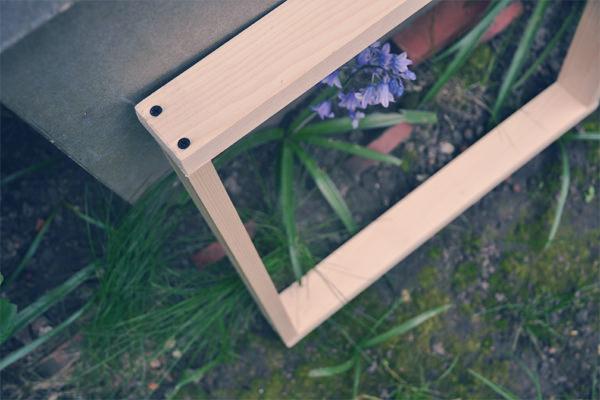
Make a frame by joining the pieces of wood. (See the photo above)
Step 2
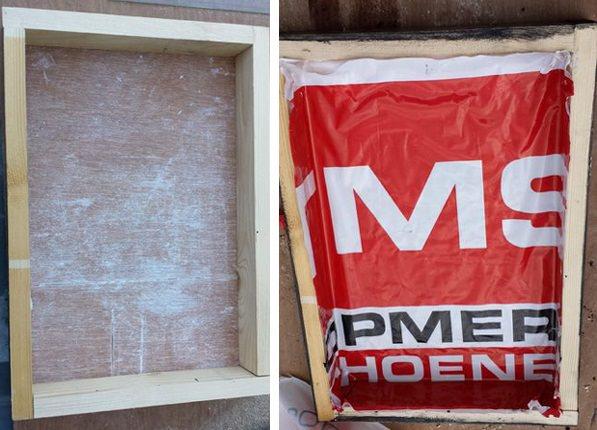
Measure and cut the plyboard or picture frame board to cover the frame from behind according to the dimensions of the frame. Once you join it to the frame with nails and glue, stick a plastic bag or film over it. To make your vertical succulent wall waterproof.
Step 3
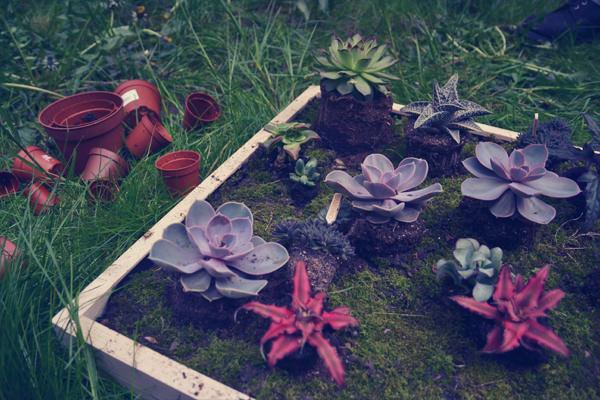
Evenly spread the soil in your frame. Stop filling just before the soil reaches the edge of the frame.
Step 4
Before fixing the chicken wire on your succulent wall planter, distribute moss over the soil (optional) and put succulents to see and adjust them according to colors, shapes and sizes. This is fun! Once you have found the ideal location for your small plants, remove them again.
Step 5
Attach the chicken wire using a staple gun on the edges of the frame. You can skip this step if you want but chicken wire is used to support the succulents and soil.
Step 6
Now plant the succulents. Skip this step if you are planting them from cuttings but if you are planting potted succulents you may need to cut chicken wire mesh to create a few small planting holes to transplant succulents with the help of a pincer or wire cutter.
Step 7
Poke holes in the soil and then gently tuck the plants in and close the hole and mist the soil to moisten it.
Wait a few days before hanging your DIY succulent wall planter or putting it vertically until the plants recover and establish well.
How to Care for Succulent Wall PlanterPosition
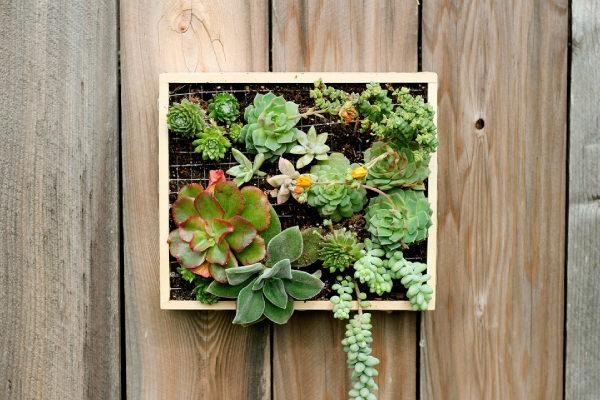
Keep the succulent wall planter on a table, near a windowsill, in your living room, somewhere where it will receive some sun or indirect sunlight. You can also hang it on the wall but for this, you’ll need to attach a picture hanger to your frame.
Watering
Spray water on your vertical succulent wall to keep the soil slightly moist in the next few days. Once established water only when the substrate is slightly dry. Be attentive to it and observe when the plants need water.
Soil
Right kind of soil is the key as you’re growing plants vertically in a too small space. Use succulent potting mix for this.

Succulents are easiest plants to grow on earth. They are not demanding and most of them grow in severe conditions, plus they come in different colors, sizes, and shapes. All this makes them perfect for vertical gardening.
Things you’ll need to make DIY succulent wall planter

SucculentA tape to measureChicken wireA hammerNailsA pencil or MarkerGlueSpecial potting mix for cacti and succulentsMore succulents4 equal size thick sticks or frame moulding to make frameMoss (Optional)A piece of board (plywood or something else) to adhere behind the frame.Staple gun or whatever you find easily to attach the chicken wire to the frame.Pincer or wire cutter to cut wiresSteps to Follow
Step 1

Make a frame by joining the pieces of wood. (See the photo above)
Step 2

Measure and cut the plyboard or picture frame board to cover the frame from behind according to the dimensions of the frame. Once you join it to the frame with nails and glue, stick a plastic bag or film over it. To make your vertical succulent wall waterproof.
Step 3

Evenly spread the soil in your frame. Stop filling just before the soil reaches the edge of the frame.
Step 4
Before fixing the chicken wire on your succulent wall planter, distribute moss over the soil (optional) and put succulents to see and adjust them according to colors, shapes and sizes. This is fun! Once you have found the ideal location for your small plants, remove them again.
Step 5
Attach the chicken wire using a staple gun on the edges of the frame. You can skip this step if you want but chicken wire is used to support the succulents and soil.
Step 6
Now plant the succulents. Skip this step if you are planting them from cuttings but if you are planting potted succulents you may need to cut chicken wire mesh to create a few small planting holes to transplant succulents with the help of a pincer or wire cutter.
Step 7
Poke holes in the soil and then gently tuck the plants in and close the hole and mist the soil to moisten it.
Wait a few days before hanging your DIY succulent wall planter or putting it vertically until the plants recover and establish well.
How to Care for Succulent Wall PlanterPosition

Keep the succulent wall planter on a table, near a windowsill, in your living room, somewhere where it will receive some sun or indirect sunlight. You can also hang it on the wall but for this, you’ll need to attach a picture hanger to your frame.
Watering
Spray water on your vertical succulent wall to keep the soil slightly moist in the next few days. Once established water only when the substrate is slightly dry. Be attentive to it and observe when the plants need water.
Soil
Right kind of soil is the key as you’re growing plants vertically in a too small space. Use succulent potting mix for this.
1
0
Lucky Coyote
2017年05月20日

There's amazing, real-time succulent game called Viridi that is absolutely amazing 😺 it's available for Android, iOS, and windows, I think it's a great meditation tool and your own succulents-away-from-home 😺


2
0
Lucky Coyote:@EverythingForCacti unfortunately, not that I've found, I'm still looking and hoping though
EverythingForCacti:anything else like this app?
Nicole Rebecca Vincent:I love this app!
求助
Lucky Coyote
2017年05月20日

I'd love to know what type of succulents these are :) there are so many of them in my neighborhood growing out of the sidewalk and into the street
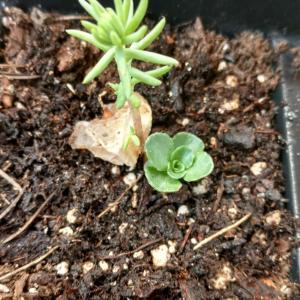
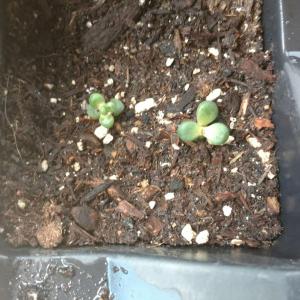


1
1
Ueca:*Bump* The vegetable-looking one is Sedum spurium.
Lucky Coyote:@Ueca Oooh I'd love to when they develop better roots 😺
Ueca:Pick some and mail them over to me here in Canada! ;D
Lucky Coyote:I meant to add these as well
求助
Gigi Allas Barimbao
2017年05月18日

Is it okay to water my succulents once in a week in a tropical country like Philippines? It looks like my perle von is not healthy@Succulent Hauz @alexcc @succulents are my drug


0
0
Gigi Allas Barimbao:@Jude thank you
Sepideh Maleki:You're welcome
Jude:succulents are better off needing water.. the less water you put in it the more babies you will have
Gigi Allas Barimbao:Thank you
Sepideh Maleki:Put a toothpick in the soil after watering.In the next days take it out to check if it is dry.Only water if it feels completely dry.This works really well for me!



